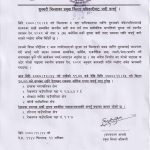BABY CORN : A NUTRITIOUS DIET

Nepal is the third most important cereal crop after rice and wheat and has the highest production among the cereals. Known as “queen of cereals” ; it has become one of the most staple foods in many parts of the world , with the total production of maize surpassing that of wheat and rice . Maize can be broadly classified into 7 types which are:
1. Flint corn
2. Dent corn
3. Soft corn
4. Pop corn
5. Sweet corn
6. Waxy corn
7. Pod corn
Baby corn also known as young corn, mini corn or candle corn is the ear of a maize plant harvested young, when the silk has either not emerged or just emerged and no fertilization has taken place . Baby corn is a good option for crop diversification and the value addition of maize as well as growth of food processing industries. The crop being preferred in different forms is a rich nutritive vegetable from the viewpoint of nutrition . Being a short duration crop , it can only be included in multiple cropping systems also . It is gaining attention among farmers because of its low cost of production , high demand within the countries , scope of value addition , support to local economy and increased income. Production of baby corn is in many ways similar to practices recommended for normal grain maize production . A few exceptions can occur for high plant population density, detasseling and early harvest. But in Nepal, its production is found to be very negligible.
Nutritional value of baby corn:
Baby corn is a delicious , decorative and nutritious diet without cholesterol. One baby corn can be compared with an “egg” in terms of minerals. It also has nutritive advantage with high Phosphorus content (86mg/100g edible portion), folate , fibre, vitamin B low calorie.
Probably baby corn is the only diet without any pesticide residues. Due to its high succulence ,palatibility and digestibility it is considered to be an ideal fodder crop . As per the report of EIRI, the nutritive value of baby corn on dry weight basis is:
- Protein: 15-18%
- Sugar: 0.016- 0.020%
- Phosphorus: 0.6-0.9%
- Potassium:2-3%
- Fibre: 3-5%
- Calcium: 0.3-0.5%
- Ascorbic acid: 75-80mg/100 g
Also it is a rich source of thiamine, riboflavin and ascorbic acid .
Uses: Baby corn can be eaten raw / cooked . It is used as a decorative , crispy vegetable in salad, soup, pasta, manchurian, raita, pakodas, dry vegetable, kofta curry, candy jam, burfi, halwa, kheer , fried baby corn with meat and rice and other favourite dishes. It is used in a variety of traditional and continental dishes besides being canned. It can also be used after boiling and blanching. Dry leaves and cob covering can be used as good fuel.
Benefits of having baby corn:
- Low in carbohydrates that is absolutely fine for our health.
- Acts as a broom and helps to maintain good bowels and avoid constipation.
- Good source of folate that is necessary for development of growing fetus and to prevent neural tube defects.
- Notable amount of B – Vitamins especially vitamin B1.
- Notable amount of vitamin- C.
Production system:
Soil: clay loam to sandy loam soil having PH 5.5-7.5 is most suitable to produce baby corn. Soil must be well drained , well aerated and a high amount of organic matter should be supplied.
Field operation: One deep ploughing followed by 1-2 harrowing should be done to obtain a good tilth, sufficient aeration for germination and emergence of maize.
Nutrient management: Well-decomposed FYM @5 t/ha +vermicompost @ 1 t/ha should be applied 20 days before sowing of crop for obtaining higher yield.
Season: February-March (pre-kharif crop) and April-May (kharif crop) and June July (late kharif) is ideal.
Varieties: Cultivars like Madhuri sweet corn, Priya sweet Com, Amber popcorn, VL-42, VL 45, MTH 14, HIM-129, Golden Baby, PAC 793, VL Baby com 1, G-5416, MH-4
Seeds and sowing:
seed rate: 18-20 kg/ha sown on ridge with a spacing of 15 cm between plant to plant and 45 cm from row to row. About two seeds per hill should be sown at a depth of 4-5 cm and thinning of one plant may be done after 8-10 days of germination to give the required population.
Weeding:
Two hand weeding is recommended at 15 and 45 days after germination fallowed.
Cropping system:
It is better to grow leguminous crop as an intercrop in baby corn which makes it more remunerative. Crops like urd bean, soybean and cowpea etc. are best suited with baby corn.
Water management:
In baby corn, 15-20 days after sowing, knee-high stage and pre flowering are the critical stages of irrigation. Excess water and water stress is equally or even more harmful as the crop cannot tolerate stagnant water and is very sensitive to water-logging. Water stagnation even for 6-7 hours in baby corn fields almost spoils the whole crop. Therefore, efficient drainage is of great significance than irrigation .
Detasseling:
Removal of male inflorescence soon after its emergence is called detasseling. This process is very crucial in baby corn to maintain its quality. It should be practiced row wise.
Maturity:
50-55 days after sowing, 3-4 small shoots (ears of 10 to 15 cm long) can be seen in each baby corn plant. Couple of days later, the silk emerges and the shoots are ready for harvest. Within 24 to 48 hours of reaching this stage (called silk emergence stage), the shoots should be harvested. At this stage, the shoots with husks are about 15-20 cm or ear size is 8 to 10 cm long, 1-1.5 cm in diameter and weigh 7-8 g.
Harvest:
Baby corn is ready for harvest after 50-60 days after sowing. For baby corn as a primary crop, harvest all ears within 1-2 days after silk emergence. The high density planting allows production of more and high quality ears per unit area. Harvest can be made 8-10 times over a period of 3-4 weeks. After 8 or 10 days of first harvest, second and third cobs will be ready for harvesting. For baby corn as a secondary crop, harvest the 2 and 3″ ears leaving the bottom most ears to mature for sweet corn or popcorn or green cob. This method allows farmers to use the secondary ears which otherwise may not mature for green cob or sweet corn or pop corn production. Small cobs are to be harvested immediately a day after silk emergence without damaging the plant. Harvest can be made 8-10times over a period of 3-4 weeks. Small cobs are to be harvested immediately a day after silk emergence without damaging the plant.

 एउटा यस्तो विषालु भ्यागुता, जसको मुल्य नै पर्छ ३ लाख, जान्नुहाेस्
एउटा यस्तो विषालु भ्यागुता, जसको मुल्य नै पर्छ ३ लाख, जान्नुहाेस्  भोलि र पर्सि बालबालिकालाई भिटामिन ए खुवाइदै
भोलि र पर्सि बालबालिकालाई भिटामिन ए खुवाइदै  खगराज अधिकारी गण्डकीको मुख्यमन्त्री नियुक्त
खगराज अधिकारी गण्डकीको मुख्यमन्त्री नियुक्त  सुनसरीमा दुवै पक्षबीच सहमति, कर्फ्यु खुकुलो हुदै
सुनसरीमा दुवै पक्षबीच सहमति, कर्फ्यु खुकुलो हुदै  स्टेफेनको शतकमा आयरल्याण्ड वोल्भ्सले नेपाल ए लाई दियो २८५ रनको लक्ष्य
स्टेफेनको शतकमा आयरल्याण्ड वोल्भ्सले नेपाल ए लाई दियो २८५ रनको लक्ष्य 


